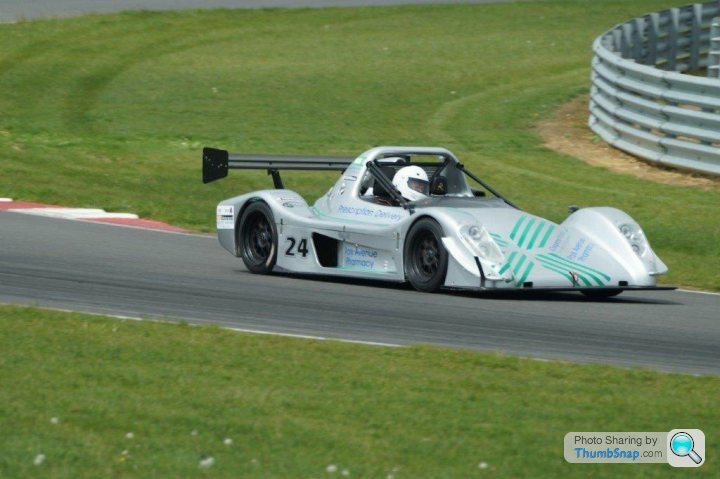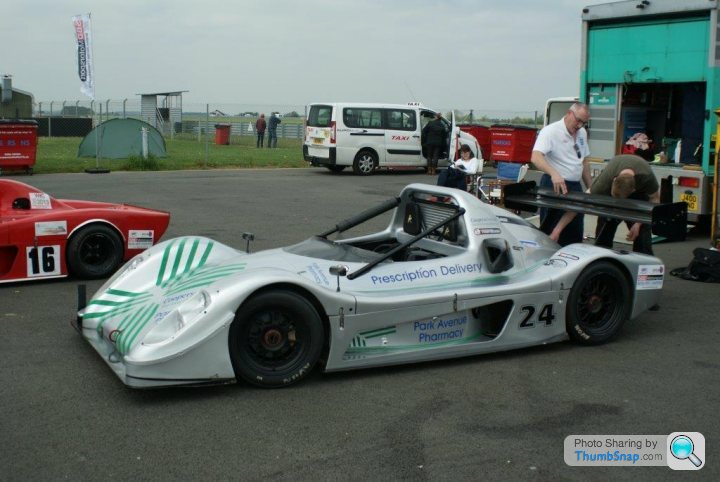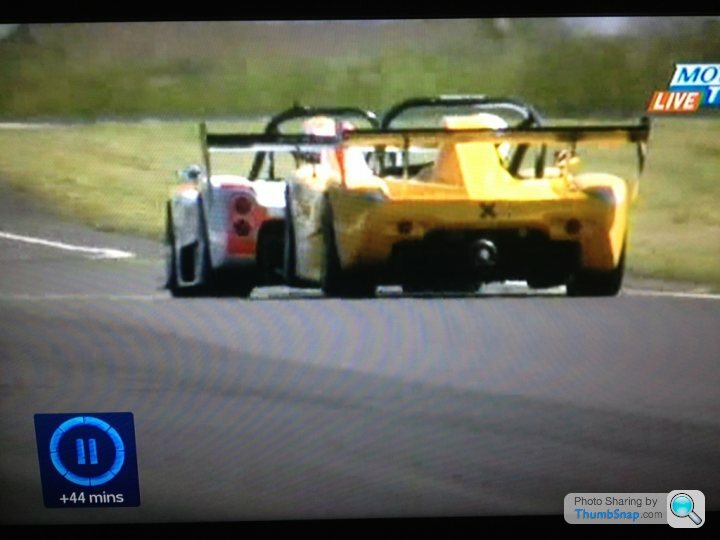Discussion
Sorry to spoil this for you guys but this is a mirage. An optical phenomenon very common in sunny days. It's caused by the redirection of the reflected light rays form the object, in other words, is a real physical phenomenon and not just an optical illusion. The sun light in the direction of the road gets refracted due to the temperature gradient (continuous change) of the layers of air. This refraction causes the redirection of the sun rays and finally it gets reflected (total reflection) from the layers of air near the surface of the road.
We all know this as the "wet road" phenomenon when looking ahead during hot days on long roads.
Plenty of pictures on the internet with race cars "in the air" on all four tyres.
We all know this as the "wet road" phenomenon when looking ahead during hot days on long roads.
Plenty of pictures on the internet with race cars "in the air" on all four tyres.
Sorry to spoil this for you guys but this is a mirage. An optical phenomenon very common in sunny days. It's caused by the redirection of the reflected light rays form the object, in other words, is a real physical phenomenon and not just an optical illusion. The sun light in the direction of the road gets refracted due to the temperature gradient (continuous change) of the layers of air. This refraction causes the redirection of the sun rays and finally it gets reflected (total reflection) from the layers of air near the surface of the road.
We all know this as the "wet road" phenomenon when looking ahead during hot days on long roads.
Plenty of pictures on the internet with race cars "in the air" on all four tyres.
We all know this as the "wet road" phenomenon when looking ahead during hot days on long roads.
Plenty of pictures on the internet with race cars "in the air" on all four tyres.
BioBa said:
Sorry to spoil this for you guys but this is a mirage. An optical phenomenon very common in sunny days. It's caused by the redirection of the reflected light rays form the object, in other words, is a real physical phenomenon and not just an optical illusion. The sun light in the direction of the road gets refracted due to the temperature gradient (continuous change) of the layers of air. This refraction causes the redirection of the sun rays and finally it gets reflected (total reflection) from the layers of air near the surface of the road.
We all know this as the "wet road" phenomenon when looking ahead during hot days on long roads.
Plenty of pictures on the internet with race cars "in the air" on all four tyres.
Now, that's really clever!We all know this as the "wet road" phenomenon when looking ahead during hot days on long roads.
Plenty of pictures on the internet with race cars "in the air" on all four tyres.
If the picture has not been Photoshopped (other photo editing products are available) then that refraction is a clever old bird as it's lifted both front wheels off the road and the front wings so that the body is clearly nose up rather than nose down!

Will we ever know?
However, approaching the question from an aerodynamic fundamentals position you will observe that in side view a classic sports racer body (Clubsport/Prosport) mirrors that of a (lifting) wing. So, if we make no aero interventions at all, it will when dragged through the air generate lift and eventually fly. IIRC we discussed this here a few years ago and Angus recounted the story of how his dismounted (Clubsport not personal) body took off and flew (this was allegedly before any Spirit of the Gods had been consumed
 ) across the paddock at some breezy spot like Harewood or Kames. Perhaps he'll pop by and remind us.
) across the paddock at some breezy spot like Harewood or Kames. Perhaps he'll pop by and remind us. 
Perhaps I should point out that if I saw Angus fly across the Paddock at Harewood I would have to reconsider my views on both theistic religion and the consumption of alcohol.

Sports racing cars flying is serious issue and one on which the ACO has regulated heavily (sadly with limited success as Anthony Davidson will attest http://www.youtube.com/watch?v=A8jJB6viADM)
 . I have always worked on the basis that when considering
. I have always worked on the basis that when considering  the aero design of Sports Racers idea one starts by thinking about how to counter their natural tendency to fly and then moves on to the generation of positive downforce and obtaining balance across the speed range
the aero design of Sports Racers idea one starts by thinking about how to counter their natural tendency to fly and then moves on to the generation of positive downforce and obtaining balance across the speed range  .
.Joyeux vendredi a tous!

Just like LCM says.
All the ingredients are there in the photo to 'prove' this partial quote from Wiki >
But some cars have had rather unstable aerodynamics, such that a minor change in angle of attack or height of the vehicle and this can cause large changes in the downforce. In the very worse cases this can cause the car to experience lift, not downforce, for example, caused by a bump on the track or slipstreaming over a crest, and sometimes can have disastrous consequences. A notorious example of this was Peter Dumbreck's Mercedes-Benz CLR in the 1999 Le Mans 24 hours, which flipped spectacularly after closely following a competitor car over a hump.
I suppose the lesson here is never ever put your nose dangerously close to another bloke's ....... especially when you've just been humping?
All the ingredients are there in the photo to 'prove' this partial quote from Wiki >
But some cars have had rather unstable aerodynamics, such that a minor change in angle of attack or height of the vehicle and this can cause large changes in the downforce. In the very worse cases this can cause the car to experience lift, not downforce, for example, caused by a bump on the track or slipstreaming over a crest, and sometimes can have disastrous consequences. A notorious example of this was Peter Dumbreck's Mercedes-Benz CLR in the 1999 Le Mans 24 hours, which flipped spectacularly after closely following a competitor car over a hump.
I suppose the lesson here is never ever put your nose dangerously close to another bloke's ....... especially when you've just been humping?
LCM said:
If the picture has not been Photoshopped (other photo editing products are available) then that refraction is a clever old bird as it's lifted both front wheels off the road and the front wings so that the body is clearly nose up rather than nose down! 
I gave it a shot but have to admit defeat.
Yes, at Knockhill on a particularly windy day (even for Knockhill) I had all the bodywork just resting on the pegs awaiting scrutineering and turned round just in time to see it land back on the ground and go chasing after it travelling down the paddock.
Incredibly lucky not to hit anything or anybody we all know how heavy the bodywork is.
Incredibly lucky not to hit anything or anybody we all know how heavy the bodywork is.
SportsLibre said:
Yes, at Knockhill on a particularly windy day (even for Knockhill) I had all the bodywork just resting on the pegs awaiting scrutineering and turned round just in time to see it land back on the ground and go chasing after it travelling down the paddock.
Incredibly lucky not to hit anything or anybody we all know how heavy the bodywork is.
Thanks Angus.Incredibly lucky not to hit anything or anybody we all know how heavy the bodywork is.
I'm sorry to have maligned Harewood (what they have are mere zephyrs compared with the real culprit) for I should have thought first of Knockhill when referring to a bad case of wind......

RWDKurt said:

This is a picture of my car last weekend about half way round Palmer curve on the Snetterton 100 circuit - speed circa 80mph (guess). The car felt great at the time but the nose looks high - any thoughts from those with more experience?
Firstly the guessing game:
- you have lower roll stiffness at the front than the rear
- you were power on when the pic was taken
- you don't have a diffuser FUT but are relying on those (non-thin foil) dive planes and splitter for front downforce. BTW, we've "done" dive planes recently here: http://www.pistonheads.com/gassing/topic.asp?h=0&a...
Secondly, what does the chassis rake look like static?
Don't think that apologies are needed Dunc.
Aero stability and safety are probably the key issues for sports racers and something that we should all care about. Unlike trying to leech my suspension set up or the finer points of aero performance, basic aero safety is an area where I'm always happy to share what I know and have learned from (sometimes) painful and expensive experience.
Aero stability and safety are probably the key issues for sports racers and something that we should all care about. Unlike trying to leech my suspension set up or the finer points of aero performance, basic aero safety is an area where I'm always happy to share what I know and have learned from (sometimes) painful and expensive experience.
Thanks to both Dunc and LCM for their comments. I am at the very bottom of a steep learning curve with aero cars and am a very long way from worrying about the finer points of setup!

The car sits a little high at the front; the previous owner used the car on bumpy Irish hills and has modified (lengthened) the front damper top mounts to give better ground clearance. I suspect that these may be at the root of the issue.

The car sits a little high at the front; the previous owner used the car on bumpy Irish hills and has modified (lengthened) the front damper top mounts to give better ground clearance. I suspect that these may be at the root of the issue.
BertBert said:
The first thing I'd do would be to get the standard factory settings from the R boys and get it set to that. That'll be a good starting point from which to play.
Bert
Ah yes. Bert
BUT.
The factory settings are for Dunlops and suggest a nose high stance - 85mm F and 75mm R (wet and with the bill-payer on board) measured at the usual places.
Avons are very different. I run my SR8 on much more conventional "Avon-style" settings (ie with lowish camber and positive chassis rake) and that works just fine.
Gassing Station | Radical | Top of Page | What's New | My Stuff





